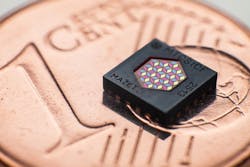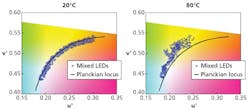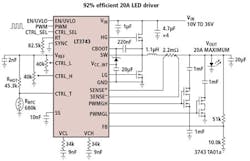Maintaining accurate output and colors in a dynamic LED-based system is a challenging task, but JEFF GRUETTER and KEVIN JENSEN describe how sensors and an active feedback circuit in the driver can optimize SSL systems.
Quality light output, tight lumen maintenance, and smooth dimming are common concerns in many LED-based lighting applications. To achieve such characteristics, product developers can turn to driver-circuit implementations that utilize a sensor (Fig. 1) and active feedback. The design problem is further complicated when dynamic color is involved. This article will examine a design approach relative to an LED-based digital light processing (DLP) projection system that could be adapted to a variety of color solid-state lighting (SSL) systems.
Indeed, there is an increasing breadth of SSL applications. High-brightness white LEDs are quickly replacing incandescent lighting in many home, institutional, government, and industrial applications. In many cases, the higher efficiency of the LEDs reduces power consumption by as much as 88%, dramatically reducing the carbon emissions required to generate the electricity to power them. Large arrays of white LEDs are replacing cold-cathode fluorescent lamp (CCFL) lighting for backlighting large LCD-TFT panels found in HDTV applications. LEDs' higher efficiency, long life, and ability to offer local dimming capability have enabled LCD HDTVs to attain contrast ratios in excess of 7,000,000:1, exceeding the CCFL-based designs by orders of magnitude. So it is not surprising that with the proliferation of LED lighting in so many applications, their growth rate continues to accelerate. All such applications require complex control strategies in the driver electronics for optimum performance.
FIG. 1. A color sensor with integrated filter capabilities, such as the MTCSiCF, can enable long-term stability in dynamic RGB-based systems.
Challenges with LED technology
Achieving homogenous light output values using LEDs and electronics from different manufacturers can be a challenging task, especially for dynamic control options. Traditionally, purchasing very narrow and limited LED bins has been one costly solution to the uniformity problem and the challenge intensifies with color. In projects, these restrictions tend to be very expensive as limitations in long-term component availability and storage options make this solution hard to reproduce in future projects.
Achieving component-inventory savings by changing the selected LEDs or manufacturer can be an alternative while also a hard task to perform, since LEDs alter in color and brightness due to process technology, phosphor, aging process, and temperature shifts during operation. The subsequent replacement of defective fixtures in larger LED lighting installations may also lead to unforeseeable problems regarding quality and conformity of the light output, even when using high-quality LEDs.
LED brightness, for example, decreases by almost 40% during temperature drifts of 5°C (41°F) to 70°C (158°F). Shifts within the color perception and brightness of mixed light are inevitable, and Fig. 2 shows an example of color shift relative to temperature. Different LEDs also shift in color over time and the aging process differs for LEDs in different colors, as depicted in Fig. 3, characterized by forward current change.
Especially in larger projects consisting of multiple light sources, it is problematic to maintain stable light color conditions. Even inexperienced viewers can see color differences and heterogeneous light color conditions at color point tolerance levels of ΔE = 2.5 to 3 [the color shift metric defined by the CIE (International Commission on Illumination)]. For some background on color science, see the LEDs Magazine series on the topic.
Ultimately, the user must decide how to calibrate the light source, depending on environmental influences (such as temperature or pressure) and desired output of light color. The other option could be real-time sensing and control.
LED lighting for DLP projectors
Now let's consider an approach to the consistency issue relative to a specific application. The introduction of high-current LEDs has enabled use in high-power lighting applications, replacing relatively inefficient incandescent bulbs. In applications such as architectural lighting and DLP projectors, legacy designs require 500W to 1000W, or even 5000W incandescent or halogen bulbs, along with a color wheel to generate the dynamic colors. Such designs are a thermal challenge and the lamps used in such systems have short lifetimes.
LEDs can simplify the design and provide far greater energy efficiency, assuming you can solve the color- and lumen-output-consistency issue. Indeed, 20A LEDs can offer the same light output, in lumens, of some lamps used in DLP projectors, but only require 20% of the electrical power. Still, in architectural applications, the LED driver must be very efficient and offer wide dimming ratios to maintain a constant light output in a wide array of ambient conditions.
FIG. 2. Temperature changes can lead to significant shifts in color among a group of LEDs in an SSL system.
New DLP lighting designs use an array of high-current RGB LEDs in lieu of a high-power bulb, color wheel, and mirrors. The combination dramatically reduces the magnitude of wasted heat, and thermals were a huge problem in legacy lamp-based systems. The LED approach can further improve the accuracy of color mixing, dramatically improve contrast ratios and overall resolution, and yield longer product lifetime.
To reach the desired level of performance in SSL-based projectors, a unique LED driver design is required. First, the driver must be able to deliver up to 20A of continuous LED current and pulsed currents up to 40A. Second, it must offer efficiency in excess of 90% to minimize thermal considerations. Finally, in order to achieve the wide dynamic range required in color mixing, it must be able to switch between three well-regulated current states rapidly and accurately without any disruptions.
Color mixing in DLP applications
Indeed, color mixing is a major design challenge in high-end DLP projection applications based on RGB LEDs. For background information on color mixing, see a feature article on that topic.
Accurate LED drivers for color systems must be able to rapidly switch between two disparate regulated peak current states and overlay pulsewidth modulation (PWM) dimming without disruption. Designing high-current LED driver ICs that are capable of meeting these demanding speed and accuracy requirements, while optimizing overall efficiency, has posed many new challenges for IC designers.
FIG. 3. RGB LEDs age differently in terms of lumen output and color, partially due to changes in drive current over time.
Active feedback loops provide a solution for high-quality applications. Such systems can actively monitor the color output and match the target color with the required color via microcontroller (MCU) computations that are directly sent to the LED drivers. Fig. 4 depicts a basic system implementing such an architecture.
Sensing and feedback
The demonstrated solution differs from the lower-precision, unregulated control option by implementing a color sensor, depending on the lighting concept, to send RGB or other color values to the MCU to directly regulate the LED light output. The software run on the MCU compares the given and set values and directs these to the output driver. This concept works for any LED light source, either RGB, RGBW (RGB plus white), or RGBx (with additional colors) and in various applications. Another benefit for DLP projectors is that the startup time for projectors can be drastically reduced, since the temperature influence of LEDs can be compensated via the features of the active feedback monitoring.
One option for implementing the sensing function is the MTCSiCF from MAZeT. The product is a true color-sensor IC with a filter function based on CIE 1931/DIN 5033 standards for human eye perception. Such a sensor can be long-term stable over the entire product lifetime and resistant to external influences such as temperature drifts. MAZeT uses Jencolor interference filter technology to achieve the stability. This technology provides unprecedented results in color matching in LED and DLP applications.
FIG. 4. A microcontroller and sensor enable accurate real-time feedback and precise color control.
Interference filters with micro stacks only let specific wavelengths reach the detector and do not drift in wavelength over time or via temperature influences. As opposed to absorption filter-based sensors (standard in common color sensors), the interference filter technology does not rely on degradable filter materials. Therefore, they are ideal for long-term stable compensation and correction of specific color values such as CCT, color brightness, or coordinates. High transmission ranges and low cutoff in the region beyond 95% provide pinpoint accuracy even in challenging applications and environments. True Color sensors utilized in an LED system for feedback control enable an accuracy as tight as 1-2 MacAdam ellipses.
FIG. 5. A driver IC must offer the accuracy and swift response required in dynamic SSL applications such as RGB projectors.
The proposed system also requires an analog-digital-converter (ADC) function to take the sensor output and provide the feedback input to the MCU (not shown in Fig. 4). One option for an ADC is the MAZeT MCDC04, a 4-channel device with 16-bit resolution and an I2C interface. The converter operates based on the charge-balancing method and reaches sensitivities of 20 fA/LSB at a dynamic range of 1-to-1,000,000. The signal conditioner IC is temperature compensated and offers an external synchronization - for example, for PWM. This allows measurement of high-quality resolutions that can later on be processed by the dynamic LED driver circuit.
Driver IC options
The system also requires one or more driver ICs to take the MCU output and deliver the constant current required by the LEDs. Options include multichannel devices or a single-channel driver for each color and perhaps a white channel as shown in Fig. 4.
One single-channel option is the LT3743, a synchronous step-down DC/DC converter designed to deliver constant current to drive high-current LEDs (Fig. 5). The device's 5.5V to 36V input voltage range makes it ideal for a wide variety of applications, including industrial, DLP projection, and architectural lighting. The driver IC can provide up to 20A of continuous LED current from a nominal 12V input, delivering in excess of 80W. In pulsed LED applications, it can deliver up to 40A of LED current or 160W from a 12V input. Efficiencies as high as 95% eliminate any need for external heat sinking and significantly simplify the thermal design.
SSL designs also require that the developer consider efficiency for each new driver relative to footprint. Choosing the right switching frequency is one way to make such a tradeoff. A frequency-adjust pin on the LT3743 enables the user to program the frequency between 100 kHz and 1 MHz so development teams can optimize efficiency while minimizing external component size.
The proposed sensor-based architecture for RGB-based lighting sets itself apart from traditional lighting systems by utilizing control options of LED sources, to eliminate negative aging, as well as temperature and light color shifts while generating long-term stability and reducing potential future maintenance costs. For example, an entertainment hall can coordinate the maintenance cycles due to the monitored lifetime of multiple LED fixtures.
The suggested architecture also supports multiple application scenarios including corporate lighting schemes. Features include variable standard lighting options (such as the CIE standard D65 illuminant or others), lifetime and exchange cycle monitoring, automatic light color adaption, daylight control, etc. It allows standardized color or CCT values to meet Energy Star or government-specific regulations even while using LEDs from different manufacturers and different bins or with shifts in utilized phosphor batches.
It is important to choose a sensor that does not show aging effects and is based on the perception of the human eye and combine the sensor with driver ICs offering the accuracy and dynamic control required in the application at hand. The options discussed in the article have been demonstrated to deliver high-performance SSL-based projection systems and could also be applied in other SSL applications.
JEFF GRUETTER is a senior product marketing engineer for power products at Linear Technology (linear.com). KEVIN JENSEN handles international sales and marketing for MAZeT GmbH (mazet.de).










